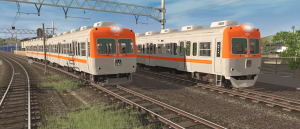
Ishikawa Line 7700 Series on the left, Asanogawa Line 8900 Series on the right.
DOWNLOAD
All the necessary dependencies are either included in this package or are avaible on the DLS. Scripts belong to their respective owners.
(Consists are included! Don’t bother with placing individual cars!)
By the early 1990s, Kanazawa city was looking to relocate the city-side terminus of the Asanogawa Line underground as part of a broader redevelopment of the Kanazawa station complex – Hokuriku Railway agreed, however, there was a key issue: at the time, the Asanogawa Line was operated by a patchwork of ten different car types, all obsolete in design, and most importantly of a composite-steel construction that didn’t comply with the stringent fire saftey regulation that came in force after the cars were built, and as such were legally prohibited from running trough any kind of tunnel, no matter how short (a mere 250m for Hokutetsu, from portal to buffers!).
Thus, and also considering the ageing fleet, Hokutetsu set forth to seek a replacement. The company reached out to Keio Railway, wich at the time had a good surplus of stainless-steel ex-Inokashira Line 3000 Series trains, freshly replaced by the newly-introducted 1000 Series, and the purchase was finalized some time later: Hokutetsu acquired 10 ex-3000 Series cab cars, wich were extensively rebuilt and modified by Keio Heavy Equipment Co. (a Keio Railway subsidiary tasked to deal with, among other things, the second-hand sale of retired rolling stock) into five 2-car sets.
Repainted in Hokutetsu’s signature deep orange and reclassified as the 8000 Series, the ex-Keio trains arrived in Kanazawa in mid-1996, ready for entering service. The 8000 Series was actually formed of two slightly different subserieses: the first two trains were classified as the “8800 Series” and were the two 3000 Series prototypes from 1962, with flat-sides and single-leaf doors, while the remaining three sets were classified as the 8900 Series and were converted from “full-production” 3000 Series trains with wide bodies and double-leaf doors.
With testing completed, the five 8000 Series sets entered service at the very end of 1996, on the 19th of December – the replacement of the older trains was istantaneous as the line’s voltage was raised from 600v DC to 1500v DC, as depsite all modifications, the 8000 Series retained it’s original, unmodified, 1500v DC traction equipment. One-man operation also began with the replacement of older trains – the 8000 Series had been indeed also adapted to be driver-only-operated.
Exactly ten years later, in 2006, an additional two ex-3000 Series cars were purchased from Keio Railway, altough unlike the previous ones, these two were intended for Hokuriku Railway’s other line – the Ishikawa Line, and specifically to replace the last remaining non-air-conditioned train in service on the railway, an ex-Tokyu 7000 Series 2-car set purchased in 1990 (along with four other sets, these others instead fitted with AC-equipment).
Converted by Keio Heavy Equipment to almost the same specifications of the earlier 8000 Series, one key difference was however in the traction equipment: unlike the Asanogawa Line, the Ishikawa Line voltage hadn’t been raised, and as such it still was 600v DC, most electrical equipment was replaced with spare parts coming from the 7000 Series’ stockpile.
Reclassified as the 7700 Series, the “additional” ex-Keio set entered service in November 2006, immediately replacing the non-air conditioned 7000 Series set, wich was however kept in running order, being intended as a spare train for additional services during the fall or winter months only.
Since then, the 8900 and 7700 Serieses (and more broadly the whole 8000 Series as well) have lived a relatively uneventful life, shuttling back and forth on their respective lines. However, by the late 2010s age became a problem, as both serieses started to deteriorate – after all, their bodyshells dated to the early 1960s, being half-a-century old, and as such, a replacement was in order.
The Asanogawa Line was given priority, due to the relative simplicity of sourcing 1500v DC stock instead of 600v DC one, and the relatively better condition of the Ishikawa Line 7000 Series. The replacement chioice fell on the 03 Series, ex-Tokyo Metro rolling stock freshly retired from Hibiya Line services. Hokuriku Railway purchased eight cab cars, wich were converted into four 2-car sets by JR West’s Kanazawa workshops, with the first set entering service in late 2020, replacing an 8900 Series set.
As of today, only one 8900 Series set and one 8800 Series set remain in service on the Asanogawa Line, and their retirement is due soon – with four 03 Series sets in service, or soon-to-be in service, Hokuriku Railway is planning to purchase an additional set, bringing the total to five, enough for a full replacement of the ex-Keio stock on the line.
On the other hand, if the 8000 Series retirement is imminent, the 7700 Series on the Ishikawa Line will remain in service for the forseeable future, as no replacement has been planned yet.
